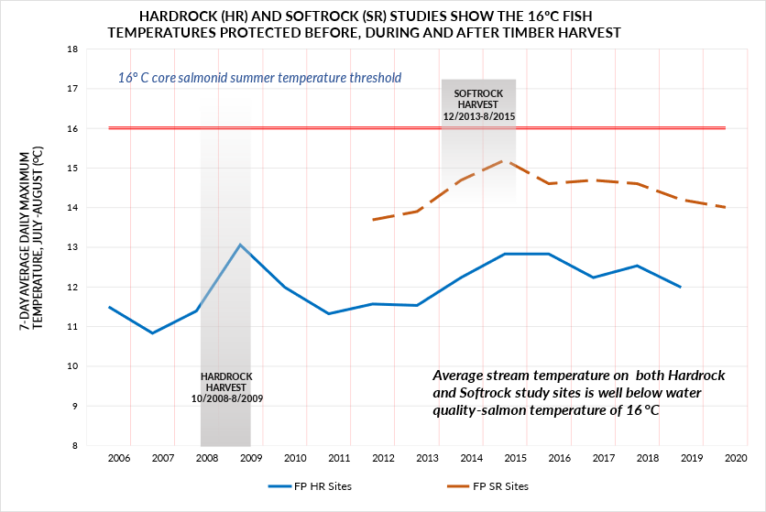A recently released decade-long series of studies examining various aspects of water quality, including temperature, shade, sediment, and amphibians, indicates that current forest practices rules, as outlined in the Forests & Fish Law, are protective of fish and meet Water Quality Standards.
The studies represent an extreme case for harvesting an entire watershed basin, which only occurs 1.4% of the time. Landowners rarely harvest an entire basin or both sides of the stream. Current rules are protective of water temperature and require intermittent buffers for the entire non-fish Np stream length and maintain at least half of the stream length with two-sided 50-foot buffers, PLUS extra buffers around potentially unstable slopes and sensitive sites. This results in actual stream buffering between 60-65% of Np streams to prevent water from warming to unsafe levels.
Current forest practices rules are the result of the historic Forests and Fish Law that was adopted 26 years ago by the legislature and signed into law by Governor Gary Locke. Private landowners set aside 764,000 acres, 15–20% of commercially productive timberland—costing them $2.36 billion, in exchange for regulatory predictability and science-based Adaptive Management rule changes tied to significant water quality harm.
On June 6, 2025, the Forest Practices Board (FPB) voted to advance only one rule proposal mandated by Department of Ecology that will take more than 200,000 acres of private forestland, $1 billion of trees, and set aside an additional 4-5% of Washington’s commercially viable forestland. This violates the Forests & Fish Law. Washington state has the most fish-protective forest practices rules in the nation. The landmark law also established a science-driven Adaptive Management program to ensure rules are protecting fish habitat and water quality and will be adjusted, based on science if they are not working.
Beginning in 2006, the studies informally known as “Hardrock” (HR) and “Softrock” (SR) measured temperature, sediment, and other water quality parameters three years before timber harvest on private forestland along non-fish-bearing waters that flow into fish-bearing waters. Then, for twelve years after harvest and during the replanting and regrowth period, the study continued to measure the same factors related to water quality. Temperatures were measured at the hottest part of the summer in July and August.
The studies found that while there was a small, temporary temperature increase between 0.6 – 1.2 degrees Celsius immediately after harvest, stream temperatures recovered as trees grow back, and never exceeded 16 degrees Celsius, the threshold established by the Washington Department of Ecology. HR temperature never exceeded 14.1 degrees Celsius. The lowest temperature was 10.3 degrees Celsius, and the average stream temperature was 12.2 degrees Celsius, well below the Water Quality Standards of 16 degrees Celsius designated to protect salmon streams.
The Forest Practices Board (FPB) is advancing a rule that lacks scientific support. The Department of Ecology’s mandated proposal is misguided. Science did not demonstrate impairment to water quality and temperature, the basis for any rule changes. Tell the FPB to reject the proposed Np buffer rule and to restart the Adaptive Management process with the proper objectives for stream temperature. Forests & Fish requres any rule changes to be based on science-based Adaptive Management recomendations. This didn’t happen.

